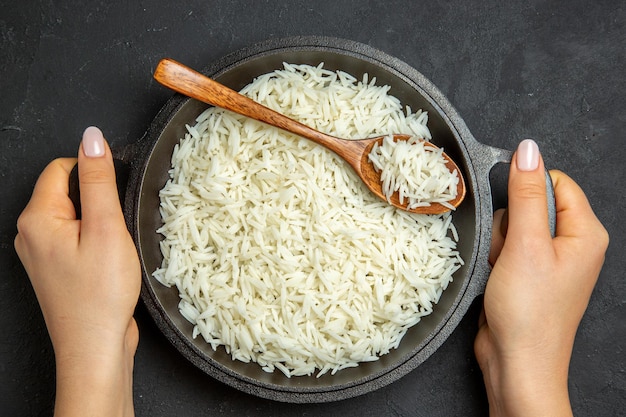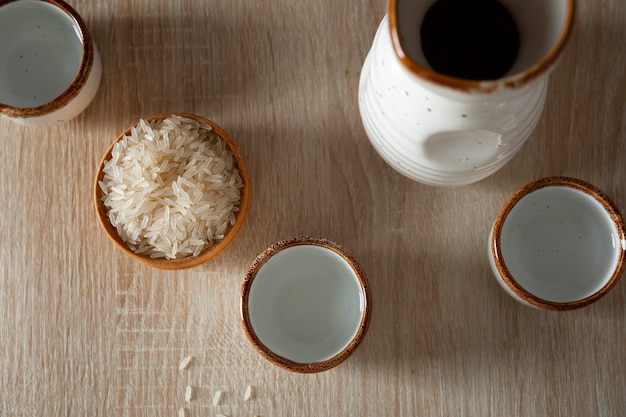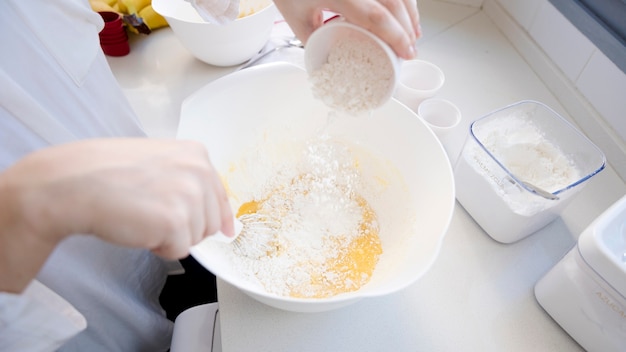Let's face it, cooking rice can be a bit of a mystery, right? One minute you're savouring a fluffy, perfectly cooked dish, the next you're staring at a sticky, mushy mess. It's enough to make you wish you'd just ordered takeaway, isn't it?
But fear not, my friends! Over the years, I've learned a thing or two about cooking rice, and I'm here to share my secrets. We'll explore the different types of rice, dive deep into the best methods for cooking it, and uncover the little tricks that will transform your rice game from "meh" to "absolutely divine". So grab a saucepan, a measuring cup, and get ready to embrace the art of perfect rice!
(Part 1) Choosing Your Rice

The first step to achieving perfect rice is picking the right type. It might sound obvious, but there's a whole world of rice out there, each variety with its own unique character and culinary purpose. You wouldn't use a Chardonnay for a red wine sauce, would you?
Understanding Rice Types
Think of rice like a family tree. At the top, you've got Oryza sativa, the species responsible for almost all the rice we eat. Then, within this family, you've got long grain, medium grain, and short grain rice, each with its own distinct personality and suitability for different dishes.
- long grain rice: These grains are long and slender, and they cook up separate and fluffy. They're the workhorse of rice, ideal for stir-fries, rice salads, and even as a side for your Sunday roast. They're also a great base for sushi, although they need a little extra care and attention.
- medium grain rice: Think of this as a happy medium between long grain and short grain. The grains are plump and slightly sticky, making them ideal for dishes where you want a bit of texture and a touch of stickiness. It's perfect for pilafs, risotto, and even paella.
- Short Grain Rice: These grains are short and round, and they cook up very sticky and almost mushy. This is the rice you want for sushi, sticky rice pudding, and even some Asian desserts. Think of it as a warm, comforting hug in a bowl.
Beyond the Basics
Now, you've got your main rice types, but there's a whole world of interesting varieties to explore. I'm talking about brown rice, black rice, wild rice, and even red rice! Each offers unique flavours, textures, and nutritional benefits.
- Brown Rice: This is the whole grain version of white rice, and it's packed with fibre and nutrients. It takes longer to cook than white rice, but it's worth the wait for its nutty flavour and satisfyingly chewy texture.
- Black Rice: This visually stunning rice has a rich, nutty flavour and a slightly chewy texture. It's a bit more expensive, but it's definitely worth trying if you're looking for something special. It also adds a beautiful colour contrast to dishes.
- Wild Rice: Technically not rice at all, but a type of grass seed. It has a distinctive earthy flavour and a firm, chewy texture. It's often used in mixed rice dishes or as a side for game.
- Red Rice: This rice has a reddish-brown hue and a nutty flavour. It's a good source of antioxidants and is often used in salads or as a side dish. It also provides a vibrant splash of colour to your plate.
(Part 2) The Art of Measuring

You know what they say, "measure twice, cook once!" It's a saying for a reason, and when it comes to rice, it's especially true. Getting the ratio of rice to water right is the key to perfect rice, and it's all about finding that sweet spot.
The Magic Ratio
Generally speaking, the standard ratio for most types of rice is 1:2, meaning one cup of rice to two cups of water. However, it's a good idea to start with this ratio and then adjust it slightly based on the specific rice you're using. Certain varieties, like brown rice, may require a little more water.
Tips for Measuring
- Use a measuring cup: Avoid using a kitchen spoon or a measuring cup from your tea set. A dedicated measuring cup ensures consistency in the amount of rice and water you use, which is crucial for achieving consistent results.
- Level off the rice: Don't pack the rice into the measuring cup. Simply use a flat-edged object, like a knife, to level it off. This ensures that you are using the correct volume of rice.
- Don't be afraid to experiment: If you find the standard ratio isn't quite right, don't be afraid to adjust it by a tablespoon or two. Over time, you'll learn what works best for your favourite rice varieties.
(Part 3) Mastering the Methods

Now that you've got the right rice and the perfect ratio, it's time to choose your cooking method. There are a few popular ways to cook rice, each with its own advantages and disadvantages.
The Stovetop Method
This is the classic way to cook rice, and it's usually the easiest option. All you need is a saucepan with a lid, and you're good to go!
- Rinse the rice: This removes excess starch, which can make the rice sticky. Just give it a quick rinse under cold water until the water runs clear. This helps to prevent the rice from clumping together and ensures a fluffier texture.
- Combine the rice and water: Add the rinsed rice to your saucepan, then pour in the water.
- Bring to a boil: Place the pan over medium heat and bring the water to a boil. This ensures that the rice starts cooking evenly.
- Reduce heat and simmer: Once the water boils, reduce the heat to low, cover the pan, and simmer for 15-20 minutes, or until the rice is cooked through. This allows the rice to absorb the water gradually and cook evenly.
- Rest: Once the rice is cooked, let it stand, covered, for 5-10 minutes. This allows the rice to absorb any remaining moisture and become fluffy. This resting period is crucial for achieving perfectly cooked rice.
The rice cooker Method
If you're looking for a hands-off approach, a rice cooker is your best friend. These appliances are designed specifically for cooking rice, and they do a fantastic job.
- Measure the rice: Most rice cookers come with measuring cups, so use those to ensure the correct ratio of rice to water.
- Rinse the rice: Rinse the rice like you would for stovetop cooking, then add it to the rice cooker.
- Turn on the cooker: Most rice cookers have a "cook" button that you simply press. Then, let the magic happen!
- Keep it warm: Once the cooking cycle is complete, the rice cooker will automatically switch to a "keep warm" mode. This is perfect if you want to eat your rice later.
The pressure cooker Method
If you're looking for speed and convenience, a pressure cooker is a game-changer. It cooks rice in a fraction of the time, and it's also incredibly versatile.
- Rinse the rice: Rinse the rice like you would for stovetop cooking.
- Combine the rice and water: Add the rinsed rice and water to the pressure cooker, making sure you leave a little space at the top. This allows for steam to build up and cook the rice evenly.
- Seal and cook: Securely close the lid and cook according to the manufacturer's instructions.
- Release the pressure: Once the cooking cycle is complete, let the pressure release naturally for a few minutes. This allows the steam to dissipate safely and prevents the rice from becoming mushy.
- Fluff and serve: Once the pressure has fully released, fluff the rice with a fork and serve.
(Part 4) Tweaking for Perfection
Now, you've got the basics down, but what if you want to take your rice game to the next level? Here are a few tips and tricks to help you achieve rice that's truly exceptional.
The Salt Game
Adding salt to your rice isn't just about seasoning; it also helps the rice cook evenly and prevents it from sticking. Add a pinch of salt to the water before you start cooking.
The Oil Factor
A little bit of oil can help prevent the rice from sticking to the bottom of the pan. Add a teaspoon or two of oil to the water before you start cooking. This creates a barrier between the rice and the pan, preventing sticking and burning.
The Steam Power
Remember, rice cooks in the steam, not the water. Make sure your pot is tightly covered throughout the cooking process to trap the steam and ensure even cooking. This creates a moist environment that helps the rice cook evenly and develop a fluffy texture.
The Fluff Technique
Once the rice is cooked, resist the urge to stir it immediately. Let it sit for a few minutes, covered, to absorb any remaining moisture. Then, use a fork to gently fluff the rice and separate the grains. This is crucial for achieving that light and airy texture.
(Part 5) The rice variations
So, you've mastered the basics. Now it's time to get creative and explore some rice variations that will add excitement to your repertoire.
The Pilaf Power
Pilafs are a great way to add flavour and texture to rice. Simply sauté some onions, garlic, and your favourite herbs and spices in a bit of oil, then add the rice and cook according to your preferred method. The aromatic vegetables and spices infuse the rice with a delicious depth of flavour.
The Risotto Revolution
Risotto is a classic Italian rice dish that requires a little more patience and attention. But trust me, the creamy, cheesy goodness is worth it. The secret to a perfect risotto is to add the broth gradually, stirring constantly, until the rice is cooked through and creamy. This slow cooking process allows the rice to release its starches, creating a rich and creamy sauce.
The Paella Passion
Paella is a Spanish rice dish that's packed with flavour and colour. It's a great way to showcase fresh seafood, chicken, or vegetables. The key to a perfect paella is to use a wide, shallow pan and cook it over medium heat, stirring occasionally until the rice is cooked through and the bottom of the pan is slightly caramelized. This creates a crispy, crusty layer called "socarrat", which is a signature feature of paella.
The Sushi Surprise
Sushi is all about the perfect rice. It's a bit more complicated than cooking regular rice, but it's definitely worth trying if you're up for a challenge. The trick is to cook the rice slightly underdone, then use a rice paddle to spread it evenly and cool it quickly. Once it's cooled, you can form it into sushi rolls, nigiri, or any other sushi creations. The key to sushi rice is its stickiness, which allows it to hold its shape when formed into sushi.
(Part 6) The Rice Storage Secrets
You've cooked the perfect rice, but what about the leftovers? Don't worry, your rice doesn't have to go to waste. Here are some tips for storing rice properly.
The Cool Down
Let the cooked rice cool down to room temperature before you store it. This helps prevent the growth of bacteria.
The Container Choice
Store the rice in an airtight container. An old plastic Tupperware container or a glass jar will do the trick. This prevents the rice from drying out and absorbing flavours from other foods in the fridge.
The Fridge Freeze
Rice can be stored in the refrigerator for up to 4 days. If you're planning to keep it for longer, freeze it. Freezing rice is a great way to extend its shelf life and have it on hand for quick meals.
The Reheating Technique
When reheating rice, make sure it's steaming hot all the way through. Reheat it in the microwave, on the stovetop, or in the oven. This ensures that any bacteria present in the rice is killed, making it safe to eat.
(Part 7) The Rice Myths
Over the years, I've heard my fair share of rice myths. Let's bust some of these common misconceptions.
Myth 1: Overcooked Rice is Unrecoverable
Fact: Overcooked rice isn't the end of the world. You can still salvage it by fluffing it with a fork to remove excess moisture. You can also try using it in a rice salad or adding it to a soup.
Myth 2: Rice Should Be Stirred During Cooking
Fact: Stirring rice during cooking can actually make it sticky. Let it cook undisturbed, and then fluff it with a fork after it's cooked. This allows the rice to cook evenly and maintain its fluffy texture.
Myth 3: Rice Needs to Be Rinsed
Fact: While rinsing rice is a common practice, it's not strictly necessary. If you're using high-quality rice, you can skip the rinsing step. Rinsing rice removes excess starch, which can make it sticky. However, modern rice varieties often have lower starch content, making rinsing less essential.
(Part 8) FAQs
Q: How do I know if rice is cooked?
A: The best way to test if rice is cooked is to check for a "soft but not mushy" texture. You can also look for signs that the water has been absorbed, and the rice has a slightly translucent appearance.
Q: Can I use any type of water to cook rice?
A: While you can use tap water, it's best to use filtered water or bottled water. Tap water can contain chlorine and other impurities that can affect the flavour and texture of the rice. Using cleaner water will result in a more flavorful and delicate rice.
Q: How do I prevent rice from sticking to the bottom of the pan?
A: Adding a teaspoon or two of oil to the water before you start cooking can help prevent the rice from sticking. Also, make sure you're using a suitable pan with a non-stick coating.
Q: What if I accidentally overcooked the rice?
A: Don't despair! Overcooked rice can still be salvaged by fluffing it with a fork to remove excess moisture. You can also try using it in a rice salad or adding it to a soup.
Q: Can I freeze cooked rice?
A: Yes, you can freeze cooked rice for up to 3 months. Just make sure to cool it down to room temperature before you freeze it, and then reheat it thoroughly before eating.
Everyone is watching

How to Cook Frozen Lobster Tails Perfectly: A Step-by-Step Guide
RecipesLobster. Just the word conjures up images of lavish meals, special occasions, and a taste of luxury. But let's...

Pigs in a Blanket Cooking Time: How Long to Bake for Perfect Results
RecipesAh, pigs in a blanket. Just the name conjures up images of those delightful little parcels of crispy pastry en...

Pork Fillet Cooking Time: How Long to Cook It Perfectly
RecipesPork fillet, or tenderloin as it's sometimes called, is a real favourite in our house. It's so versatile, and...

The Ultimate Guide to Cooking Delicious Frankfurters
RecipesLet's face it, we all love a good frankfurter. It's a classic, simple, and always satisfying. But let's be rea...

The Ultimate Guide to Tender, Juicy Pulled Pork
RecipesRight, let's talk pulled pork. It's one of those dishes that just screams "comfort food," doesn't it? I mean...
